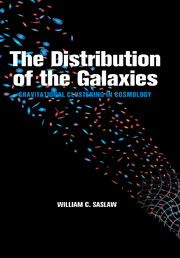Book contents
- Frontmatter
- Contents
- Prologue
- Part I Historical
- 1 Cosmogony Myths and Primitive Notions
- 2 First Qualitative Physics: The Newton–Bentley Exchange
- 3 Glimpses of Structure
- 4 Number Counts and Distributions
- 5 Seeds of Grand Creation
- 6 Clusters versus Correlations
- 7 The Expanding Search for Homogeneity
- Part II Descriptions of Clustering
- Part III Gravity and Correlation Functions
- Part IV Gravity and Distribution Functions
- Part V Computer Experiments for Distribution Functions
- Part VI Observations of Distribution Functions
- Part VII Future Unfoldings
- Bibliography
- Index
4 - Number Counts and Distributions
Published online by Cambridge University Press: 19 January 2010
- Frontmatter
- Contents
- Prologue
- Part I Historical
- 1 Cosmogony Myths and Primitive Notions
- 2 First Qualitative Physics: The Newton–Bentley Exchange
- 3 Glimpses of Structure
- 4 Number Counts and Distributions
- 5 Seeds of Grand Creation
- 6 Clusters versus Correlations
- 7 The Expanding Search for Homogeneity
- Part II Descriptions of Clustering
- Part III Gravity and Correlation Functions
- Part IV Gravity and Distribution Functions
- Part V Computer Experiments for Distribution Functions
- Part VI Observations of Distribution Functions
- Part VII Future Unfoldings
- Bibliography
- Index
Summary
I could be bounded in a nutshell and count
myself a king of infinite space.
Shakespeare, HamletIf, like Hamlet, you count yourself king of
an infinite space, I do not challenge your
sovereignty. I only invite attention to certain
disquieting rumours which have arisen
as to the state of Your Majesty's Nutshell.
EddingtonOne dominant stroke transformed thousands of years of increasingly refined speculation on the structure of our Universe into fact. Hubble (1925a,b,c, 1926, 1929a,b) clinched the extragalactic nature of the “white nebulae” by discovering their Cepheid variable stars. This vastly expanded the known distance scale.
Cepheids are unusually bright stars that pulsate with regular periods ranging from about 10 to 30 days. (The first onewas found in the constellation Cepheus in the Milky Way.) Their crucial property is the relation between a Cepheid's period and its peak intrinsic luminosity, recognized in 1908 (Leavitt, 1912; Hertzsprung, 1913). Brighter Cepheids have longer periods. From the observed periods of Cepheids in nebulae, Hubble could obtain their intrinsic luminosity and thus find the distance from their observed apparent luminosity. The main uncertainty was in calibrating their period–luminosity relation from the independently known distances of Cepheids in our Galaxy. Early calibrations turned out to be wrong, mainly because there are different types of Cepheids, which give somewhat different period–luminosity relations. (Occam's Razor fails again.)
- Type
- Chapter
- Information
- The Distribution of the GalaxiesGravitational Clustering in Cosmology, pp. 26 - 32Publisher: Cambridge University PressPrint publication year: 1999

